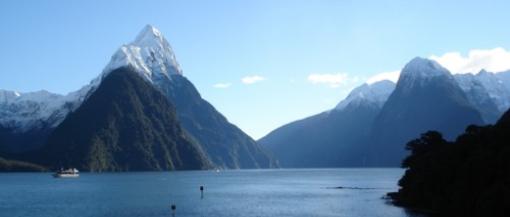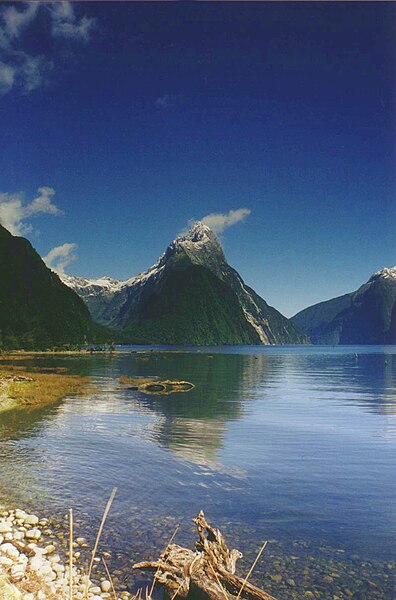Ex-Travel-Ganzer, come on, give me a break about New Zealand, this country just like piece of heaven brought to the world to be enjoyed. This is stunning right, when i open my explorer and i see this place that i will tell you later. I even can not imagine and believe how beautifull this place. The sound of water, the environment, the blue sky and so many things to see. So let me please welcoming you to the next place i recommended to you to be visited. So lets move on and lets see what we have there.
Milford Sound (Piopiotahi in Māori) is a fjord in the south west of New Zealand's South Island, within Fiordland National Park, Piopiotahi (Milford Sound) Marine Reserve, and the Te Wahipounamu World Heritage site. It has been judged the world's top travel destination in an international survey (the 2008 Travelers' Choice Destinations Awards by TripAdvisor) and is acclaimed as New Zealand's most famous tourist destination. Rudyard Kipling had previously called it the eighth Wonder of the World.
Milford Sound, located in the southwest of New Zealand’s South Island, is located within the Fiordland National Park. It runs 15 km inland from the Tasman Sea and is surrounded by sheer rock faces that rise 1200 m or more on either side. Among its most striking features are Mitre Peak, rising 1,692 m above the sound, the Elephant at 1,517 m and resembling an elephant’s's head, and Lion Mountain, 1,302 m, in the shape of a crouching lion. Lush rain forests cling precariously to these cliffs, while seals, penguins and dolphins populate the water.
Milford Sound is the most northerly of the fiords indenting the south-western coastline of the South Island; it occupies the trunk portion of a formerly glaciated valley system cut deeply below the surrounding mountains.
The mountains rise to heights of 6,000 ft above sea level, and the deepest point of the fiord, near Stirling Falls, is 1,280 ft below sea level. The Arthur and Cleddau Rivers occupy the Milford Valley and enter the head of the fiord; a delta built across the mouth of the Arthur Valley by the Cleddau River is slowly cutting off part of the Sound to form a freshwater lake. The Arthur Valley is occupied by Lake Ada, 3 miles long, which is dammed up partly by old glacial moraine and partly by landslides from the walls of Arthur Valley. From its head, the Sound follows an irregular course for 9 miles to the sea and is joined by Bowen, Sinbad, Harrison, and Stirling Rivers whose valleys were formerly occupied by tributary glaciers. Harrison Valley is still occupied at its head by a small glacier that terminates at an estimated height of 4,500 ft on the south-east slopes of Mt. Pembroke (6,710 ft). Stirling Falls (480 ft), and Bowen Falls (520 ft) spout from hanging valleys over near-vertical faces to the Sound. The inner reach of the Sound has very steep walls reaching heights of 5,560 ft at Mitre Peak and 4,150 ft at the Lion. Like many of the other fiords, Milford is deeper in the inner reaches than about the entrance, and about 1 mile seaward off Stirling Falls the deep basin rises abruptly to a sill at 360 fathoms. Beyond this the floor of the Sound forms a basin a little deeper than 360 ft, which extends out for 2 miles on to the shelf bordering the west coast; the western end of this basin is separated from the indented continental slope by a sill in 240 ft. The basin and sills were formed by glacial erosion which was a result of the confining by the steep fiord walls of the former valley glacier.
It takes a bird's-eye view to grasp the majesty of the Milford Sound fjord, one of the "oh wow" aspects of South Island's Fiordland National Park, a World Heritage site. A whopping ten miles long with sheer, 4,000-foot-high rock walls, Milford Sound gets more than 20 inches of rain a year and boasts plenty of challenging-to-explore terrain. So fly (Milford Sound Scenic Flights is a reliable flightseeing operator) and enjoy the waterfalls and snowmelt lakes without breaking a sweat.
Milford Sound offers what is probably the most spectacular fiord scenery in the southern hemisphere, and the well-known and striking views of Mitre Peak from the head of the fiord form the subject of innumerable paintings, postcards, posters, and pictorial postage stamps. The area is well served with tourist amenities, and the luxurious Hotel Milford is situated at the head of the fiord. Visitors may travel to Milford either by car or bus on the Te Anau – Eglinton – Homer Tunnel road, or by plane from Queenstown, Te Anau, or further afield, or by walking the Milford Track from Te Anau. Tourist ships occasionally visit Milford but there has been no regular service by sea for many years. Apart from the amusements provided by the hotel, the attractions of Milford are confined to sightseeing, short walks about the head of the fiord, launch trips and sea fishing and, for the more energetic, tramping and mountaineering. But the sheer impressiveness of the scenery is sufficient to make a visit well worthwhile even if it is only to the head of the fiord.
Milford Sound is a place of enchantment that will stun you with its dramatic splendour. The journey itself is a scene stealing revelation. Drive from Te Anau or Queenstown, along the shores of Lake Te Anau and you reach the rough-hewn Homer Tunnel which leads you down to the tiny settlement of Milford Sound. Head to the wharf because this is where the real adventure starts. From here you can take boat cruises along the Sound, head out sea kayaking or, for an aerial view, flightseeing. Whichever way you go you will see sights that you have never seen before – huge peaks, precipitous waterfalls and sheer rock faces tumbling into the depths of the fiord. For a different view, visit the underwater observatory and marvel at the black coral, 11-legged sea stars and delicate anemones.
If you enjoy hiking or trekking, another route to Milford Sound is to take the Milford Track. Described as the finest walk in the world, the Track begins at the northern end of Lake Te Anau and winds its way through some of the world’s most vivid and least trampled wilderness where you end the journey with a boat trip from Sandfly Point to the Milford Sound.
Tramping, canoeing and some other water sports are also possible. A small number of companies also provide overnight boat trips. There is otherwise only limited accommodation at the sound, and only a very small percentage of tourists stay more than the day.
An underwater tourist observatory found in one of the bays of the sound provides viewing of black coral, usually only found in much deeper waters. A dark surface layer of fresh water, stained by tannins from the surrounding forest, allows the corals to grow close to the surface here.
The beauty of this landscape draws thousands of visitors each day, with between 550,000 and 1 million visitors in total per year. This makes the sound one of New Zealand's most-visited tourist spots, and also the most famous New Zealand tourist destination, even with its remote location and the long journey from the nearest population centres. Almost all tourists going to the sound also take one of the boat tours which usually last between 1–2 hours. They are offered by several companies, departing from the Milford Sound Visitors' Centre. There is also the option of extended overnight cruises on Milford Sound.
In rainy and stormy days tourists can admire the play of the wind with the numerous waterfalls in Milford Sound. When meeting the cliff face the powerful wind often goes upward and waterfalls with a vertical drop get caught by wind, causing the water to go upwards.
How To Get To The Milford Sound
By road, Milford Sound is 307 km from Queenstown and 279 km from Invercargill (about four hours' drive), with most of the tour buses to the sound departing from Queenstown. Some tourists also arrive from the smaller tourism centre of Te Anau, 121 km away. There are also scenic flights by light aircraft and helicopter tours to and from Milford Sound Airport. The drive to Milford Sound itself passes through unspoiled mountain landscapes before entering the 1.2 km Homer Tunnel which emerges into rain-forest-carpeted canyons that descend to the sound. The winding mountain road, while of high standards, is very prone to avalanches and closures during the winter half of the year.
The long distance to the sound means that tourist operators from Queenstown all depart very early in the day, arriving back only late in the evening. This ensures that most tourists visit Milford Sound within a few hours around midday, leading to some congestion on the roads and at the tourist facilities during the main season. The peak-time demand is also the reason for the large number of tour boats active in the sound at much the same time.
Over the years, various options of short-cutting the distance to Milford Sound from Queenstown have been mooted, including a gondola route, a new tunnel from Queenstown, or a monorail from near Lake Wakatipu to Te Anau Downs. All would reduce the current round-trip duration (which has to travel via Te Anau), thus allowing tourism to be spread out over more of the day. While a gondola is considered to be out of the running after the DOC refused it for environmental reasons, the two other options are aiming to start consenting processes in 2007.



 8:10 PM
8:10 PM
 Unknown
Unknown







 Posted in:
Posted in: 


0 comments:
Post a Comment